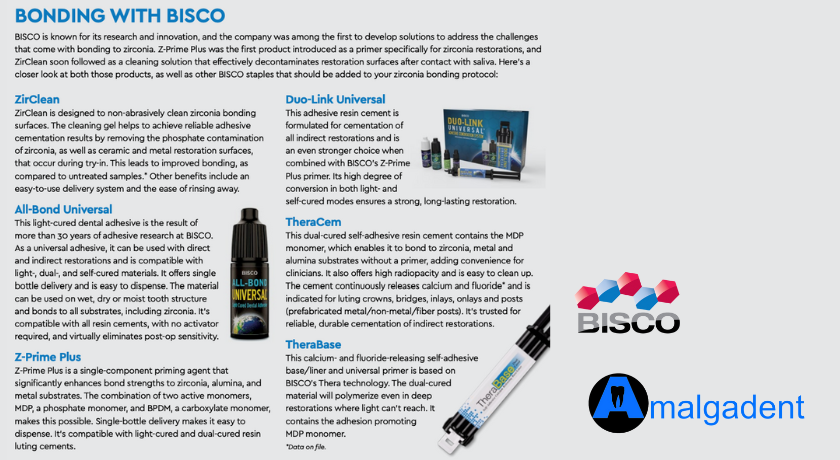Yes, You can bond to Zirconia
08/12/2023

Yes, You can bond to Zirconia
Predictable Bonds:
All You Need to Know
About Bonding to Zirconia
How the right products and protocols can help you overcome the challenges associated with this procedure.Many dentists still believe bonding to zirconia isn’t possible—and if they’re not using the proper products and techniques, they’re right. The traditional ceramic treatment doesn’t work for bonding to zirconia, and will only lead to frustration and failed restorations. Zirconia is a non-etchable ceramic, so that means hydrofluoric acid doesn’t work on it. And because zirconia doesn’t contain silica, silane isn’t an option, either.
So, how exactly can you bond to zirconia? That was a difficult question to answer at first. Compared to the traditional silica-containing ceramics that have been around for decades, zirconia is a fairly new restorative with nuances that impact bonding, BISCO’s manager of clinical marketing, Dr. Rolando Nunez said. Products like BISCO’s ZirClean cleaning gel and Z-Prime Plus primer address these nuances, making strong, reliable bonds achievable. Research shows MDP forms chemical bonds to zirconia, which is why it is critical to use products like Z-Prime Plus that contain this monomer when bonding to the substrate. Proper cleaning after intraoral try-in is also crucial, as saliva destroys the bond. Only products that are alkaline in nature, like ZirClean, can provide the nonabrasive cleaning required to achieve reliable cementation results. As with traditional ceramics, the bonding process still involves creating mechanical retention via sandblasting and surface priming. It just takes different products and protocols to get there, and what you will need varies based on the clinical situation. “Bonding to zirconia is possible,” Dr. Nunez said. “It is predictable and will yield a great clinical outcome because now there is more versatility when it comes to the type of zirconia that can be used in a vast array of clinical applications.”
Zirconia is a strong, esthetic restorative option that has become increasingly popular in recent years. It can provide patients with beautiful, long-lasting restorations, butonly if you use the right mix of products and protocols. Proper Cleaning—A Critical Step Many dentists don’t realize saliva interacts chemically with zirconia, depleting the bond, Dr. Nunez said. That means a restoration sandblasted by a lab isn’t cleaned properly—either before or after try-in—you’ll likely end up with a failed bond. It’s important to note that cleaning with water, ethanol, or acetone won’t remove the contamination. The restoration must be cleaned with specific products that are alkaline in nature, such as ZirClean. ZirClean is a restorative material cleaner that eliminates the contaminated surface between zirconia and saliva. Because the surface is exposed after the cleaning, the next step is to apply Z-Prime Plus and then follow that with All-Bond Universal and Dual-Link Universal, or justapply TheraCem, a self-adhesive resin cement that doesn’t require primer, depending on the specifics of the case. “For zirconia to have effective bonding, it requires a clean, uncontaminated intaglio surface,” said Dr. Kapish Goyal, who uses ZirClean and Z-Prime Plus at his practice in Virginia Beach, VA. “The lab etched intaglio sites have to be properly cleaned and exposed for more effective adhesion and predictability of bonding. Carboxylate functional monomers such as Z-Prime Plus enhance the bond of resin-based luting cements for adhesive cementation and have proved superior to conventional cementation.”
When Dr. Nunez talks with dentists who have experienced de-bonding after using Z-Prime Plus, they almost always find the same reason for the failure: they didn’t clean the restoration’s surface with ZirClean. “A lot of dentists encounter this problem but don’t know how to solve it,” Dr. Nunez said. “Then their bonding is not predictable, it’s not optimized. You can’t treat zirconia as a normal surface because saliva will inhibit the ability to bond.”ZirClean opens up phosphate receptors in the internal portion of the crown, said Dr. Steven Edelson, who uses the cleaning gel and other BISCO bonding products at his practice in New York, NY. This adds to the retention and adhesion of the cement. While there are other factors that can lead to failures, using the right materials is a big part of avoiding them. “It’s not a great situation having patients coming in with crowns that are falling off or being swallowed. It can be quite uncomfortable for the patient when a restoration fails,” Dr. Edelson said. “If your crowns stay in, your reputation stays intact. I have a colleague who doesn’t use the same materials I do, and I’ve noticed a lot of his crowns come out. If that happens with one of my crowns, it’s a surprise, and that’s mostly because of the materials I use.” The MDP Monomer A Must Research has shown that MDP monomers form chemical bonds to zirconia. If you’re using products without this monomer to bond tothese restorations, it’s another factor leading to failure. BISCO offers four products that contain MDP: Z-PrimePlus, All-Bond Universal, TheraBase, and TheraCem. With the introduction of Z-Prime, BISCO became the first company to offer a dedicated primer for zirconia. The singlecomponent priming agent enhances adhesion between indirect restorative materials and resin cements. It combines the MDP phosphate monomer with BPDM, a carboxylate monomer, resulting in strong bond strengths. Z-Prime can be applied either before or after the sandblasted restoration has been cleaned with ZirClean, Dr. Nunez said. Then, a bonding agent such as All-Bond Universal and a cement such as Duo-Link Universal should be applied as well. “Z-Prime enhances the bonding strength before cementation,” said Dr. Dilip Dudhat, who uses a variety of BISCO products for bonding at his practice in Lansdale, PA. “You can apply it before you try in, so before you contaminate the zirconia crown you use the primer and get the bonding strength, contaminate it and then clean it with ZirClean. But if you contaminate before you apply the primer, use ZirClean to clean up, then apply the primer and wait 30 seconds to cement the crown.”
There are dentists who opt to do the sandblasting in-house rather than sending restorations to a lab, which does change the protocol, Dr. Nunez noted. If you sandblast after the restoration has been tried in, there’s no need to use ZirClean, though some clinicians stillprefer to do so. After sandblasting and try-in, you can apply either Z-Prime or TheraCem, depending on what’s best for the individual case. For preps that have good retention and are at least 3 mm in height, TheraCem is the option many dentists choose, Dr. Nunez said. TheraCem also contains MDP for bonding to zirconia, but the self-adhesive cement doesn’t require a bonding agent or primer. This eliminates steps in the protocol while leading to strong, predictable bonds. TheraCem can be used for a majority of zirconia restorations, Dr. Nunez said, but that’s a clinical assessment doctors must make with each case. “There are clinical situations where having a good height is not achievable, so you have a short prep,” he said. “When you have a short prep, you need to rely more on the chemical bond. That’s where Z-Prime comes into play, and this is also when you need to bond to the tooth structure with an adhesive and something like Duo-Link.” Dr. Dudhat, who uses TheraCem, said one of the biggest benefits is the time it saves. “There’s no need for primer, so it’s easy to cement,” he said. “Fewer steps mean shorter procedure times. You also get better patient satisfaction from a sensitivity standpoint.” Determining the Right Protocol Zirconia is becoming a popular restorative option, but clinicians still have a lot to learn about the material. The No. 1 troubleshooting question the team at BISCO gets from dentists is, “How do I bond to zirconia effectively?” There are different ways todo this, and the answer partly depends on the specifics of the case and how the doctor approaches the procedure. But, regardless of anything else, the intaglio surface should be sandblasted and an MDP-containing primer applied to optimize the bond to zirconia. And because saliva will react with the zirconia surface after try-in, depleting the bond, a surface cleaner must be used for successful results.
Bottom line: If you follow the proper steps, you’ll achieve strong bonds to zirconia and provide patients with long-lasting, beautiful restorations. “We’ve come very far when it comes to figuring out how to bond to zirconia,” Dr. Nunez said. “It’s pretty straightforward now and there shouldn’t be any doubt about being able to bond to this surface. Zirconia has evolved into a more esthetic material that can be used in cosmetic and esthetic dentistry. It’s a fun moment for the industry because we figured it out, and dentists are doing great things with the material and creating restorations that look beautiful, leading to happy patients.”
Contact
334 Glen Huntly Road, Elsternwick, VIC, 3185
